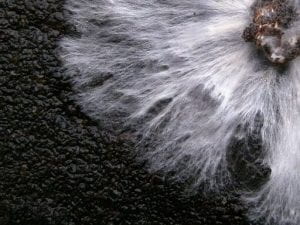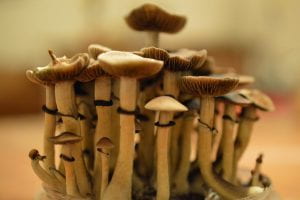Fun Fungi
A special thanks to all the women in the scientific community and their special contributions.
Recently I discovered the wonderful world of fungi. I was first drawn to this by a series of very cute mushroom plushies clouding my Pinterest feed and a bit of information from my ecology lecture. I realized I knew virtually nothing about fungi. All I knew was that they were crazy- some are bioluminescent, some are edible, and others can kill you instantly. This realization spurred a rabbit hole of research on the subject, and below is a compilation of some information I found.
Fungi, though they are sessile organisms, resemble animals more than plants. Fungi have unique characteristics, one of them being their ability to break down nutrients by releasing digestive enzymes into the surrounding environment (Lawson 2022). This is how they eat. Fungi are crucial to many of Earth’s ecosystems. Mycorrhizal fungi attach themselves to plant roots and form symbiotic relationships with plants (Martinez- Suz 2017). Fungi can be found in terrestrial environments, like the soil, aquatic, and living organisms (Blackwell 2011).
An article I found, Fungi in the Garden, describes the different types of fungi. I’ve summarized the different descriptions of these:
- Mycorrhizal- this group attaches to plant roots and forms symbiotic relationships with plants.
- Saprophytic- this group of fungi relies on decomposing matter to survive.
- Endophytic- this group lives inside plants and has a symbiotic relationship with the plant.
- Parasitic- this group siphons off energy from existing organisms, usually in a harmful way.
With this information in hand, I wanted to further explore the mycorrhizal fungi-plant relationship. This relationship is complex and seemingly under-researched. This fungus isn’t always readily visible to the human eye (unless you’re looking for it). Many people, including myself, know and understand fungi to look like mushrooms found aboveground or the yeast we use for bread. Fungi also exist in an underground world, one we have little knowledge of. According to an article by Evan Bush,
More than a quarter of Earth’s species live in soils underground, including the fungal networks that help store huge quantities of carbon, provide most plants with the majority of the nutrients they need to survive, and allow the plants to receive important signals from others.

Oyster mushroom (Pleurotus ostreatus) mycelium growing in a petri dish on coffee grounds. Photo credit: Tobi Kellner via Wikimedia Commons.
Toby Kiers, an evolutionary biologist, in an interview with Bush, described these networks as massive threads called mycelium and compared them to a pipe system containing nutrients such as nitrogen and phosphorus. Fungi are a keystone species in the different ecological communities they serve. Fungi need sugars from plants for growth (Martinez- Suz 2017). These fungi also assist plants when they are experiencing water stress. Mycorrhizal fungi help plants resist infections by nourishing them and their large physical presence intercepts the infection of other harmful pathogens (O’Callaghan 1-29).
While these interactions are fascinating, their history has a lot to tell us. The story of Suzanne Simard is one of a persistent woman in the ecological sphere, making strides and facing challenges along the way. Suzanne Simard is currently a professor of forest ecology at the University of British Columbia and the author of the book Finding the Mother Tree. Her work focused on the relationship between the trees and the vast network of mycorrhizal fungi underground.

Forest walk with Suzanne Simard at TEDSummit2016 in Banff Canada. Photo Credit: Ryan Lash / TED via Flickr.
In an interview with Dave Davies, Simard shares her experience with these discoveries and some personal insights. She describes trees as social creatures and refers to older trees as “mothers” or “hubs” as they provide saplings in the understory with nutrients to survive and release warning signals from harmful pests so that surrounding trees may produce defensive enzymes. In this interview, she also discussed how when a tree dies it disperses some of its stores of carbon to neighboring trees.
Simard’s discoveries weren’t originally welcomed; she was “dismissed, excluded, and often humiliated into keeping her mouth shut or moving on” (Hanson, 2021). Her first work received immediate pushback from established ecologists, but she never gave up and now has even more work. She faced a lot of criticism from those outside the field as well, and her credibility was repeatedly under question (Berry, 2021). Simard also doesn’t accept full credit for these findings, consistently pointing out that native cultures around the world have recognized these interconnections for many generations (Hanson, 2021).
These stories are important, and Simard has tried to show the world that the vegetation we see, the trees, are socially interconnected and complex beings that should be treated with the utmost respect. In her book, Finding the Mother Tree, she details how she grew up in the logging industry, and it was this experience that first led to her encounter with glowing yellowish fungi intertwined with the roots of healthy trees and other plants. These observations were the first of many to come, and she has tried to encourage others towards a more gentle and wholesome approach to our forests and other natural resources. Unfortunately, we haven’t seen much change in the practices concerning forestry.
Simard is an exemplary role model for young women in the scientific community. Her story is one of perseverance and an unwavering sense of self. These findings have completely altered the way many people see forests and fungi, myself included. Also, how wild is it to think about how trees can communicate with each other? How many trees have we all passed by without seeing their immense complexity? A tree has lived much longer than many of us; how much has it seen? What can these complex networks tell us about the history of the Earth? What can we learn from nature? How many things do we have left to learn? The immensity and the absolute intricacy of nature are beautiful, confusing, and something to fight for.
For more information on Suzanne Simard, please see her book Finding the Mother Tree, which can most likely be found at your local library! She also has numerous TED Talks, podcasts, and journal articles to take a look at. Please feel free to browse some of her videos.
Works Cited
Berry, Lorraine. How a descendant of loggers saved forests, inspired Richard Powers and Amy Adams. Los Angeles Times, 2021. https://www.latimes.com/entertainment-arts/books/story/2021-05-05/how-a-descendant-of-loggers-discovered-that-trees-cooperae
Blackwell, M. (2011), The Fungi: 1, 2, 3 … 5.1 million species?. American Journal of Botany, 98: 426-438. https://doi.org/10.3732/ajb.1000298
Bush, Evan. ‘Amazon forests of the underground’: Why scientists want to map the world’s fungi. NBC News, 2021. https://www.nbcnews.com/science/science-news/amazon-forests-underground-scientists-want-map-worlds-fungi-rcna7899
Dave, Davies. Trees Talk To Each Other. ‘Mother Tree’ Ecologist Hears Lessons For People, Too. NPR, 2021 https://www.npr.org/sections/health-shots/2021/05/04/993430007/trees-talk-to-each-other-mother-tree-ecologist-hears-lessons-for-people-too
Hanson, Heather. The Woman Who Wants to Change the Way We See Forests. The Story Exchange, 2021 https://thestoryexchange.org/the-woman-who-wants-to-change-the-way-we-see-forests/
Lawson, Katie. Fungi in the Garden. PBS Utah, 2022. https://www.pbsutah.org/blogs/modern-gardener/fungi-in-the-garden/
Martinez-Suz, Laura. Could fungi determine which plants survive, and which don’t? Royal Botanical Gardens, 2017. https://www.kew.org/read-and-watch/fungi-determine-plant-survival#:~:text=Fungi%20need%20sugars%20from%20plants,and%20water%20by%20several%20metres.
Suzanne Simard. Finding the Mother Tree : Discovering the Wisdom of the Forest. Knopf, 2021. EBSCOhost, search.ebscohost.com/login.aspxdirect=true&AuthType=shib&db=nlebk&AN=2564096&authtype=sso&custid=s3818721&site=ehost-live&scope=site.
O’Callaghan, Angela. Mycorrhizae. University of Nevada, Reno 01-29. https://www2.nau.edu/~gaud/bio300/mycorrhizae.htm


